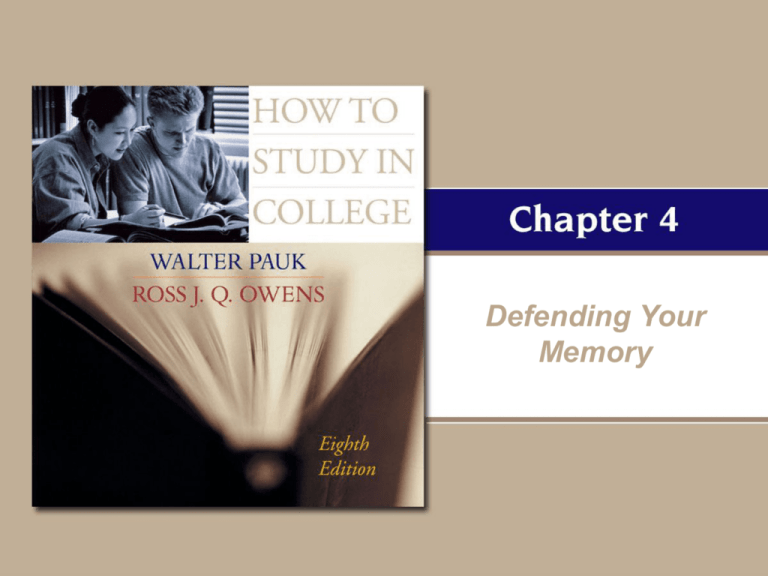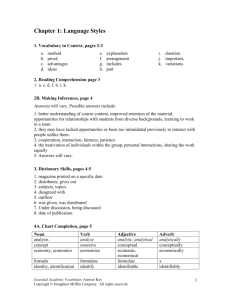
Defending Your
Memory
What is the biggest impediment to
academic success?
• Forgetting
Copyright © Houghton Mifflin Company. All rights reserved.
4–2
Proof of the power of forgetting
• 46 percent of a chapter assignment
forgotten in one day
• More than 90 percent of a lecture
forgotten in two weeks
Copyright © Houghton Mifflin Company. All rights reserved.
4–3
How does forgetting happen?
• Fading Theory: Unused memories
gradually disappear
• Retrieval Theory: Memories get lost in
the brain’s filing system
• Interference Theory: Memories get
forced out, either by other memories or
by a bad attitude
Copyright © Houghton Mifflin Company. All rights reserved.
4–4
Ways to fight back
against forgetfulness
• Make an effort to remember
• Control the size and shape of your
memories
• Work to strengthen memories
• Give your memories time to jell.
Copyright © Houghton Mifflin Company. All rights reserved.
4–5
You can’t remember unless you try
• Pseudo forgetting: Failing to
remember something you never learned
in the first place.
• Remembering for a reason: If your
reason to remember is meaningful,
forgetting is less likely.
Copyright © Houghton Mifflin Company. All rights reserved.
4–6
Improving your intention
to remember
• Pay attention. Minimize distractions
and focus on remembering.
• Get your facts straight. Incorrect
information is as easy to remember as
correct.
• Make sure you understand: If you
don’t get it, you’re apt to forget it.
Copyright © Houghton Mifflin Company. All rights reserved.
4–7
You can also use
motivation to forget
• Restaurant servers clear the table of
their memory once a party has left
• Albert Einstein kept rudimentary
information from clogging his brain
Copyright © Houghton Mifflin Company. All rights reserved.
4–8
G.A. Miller: The Magical
Number 7 and your memory
• The short-term memory is limited to
approximately seven items
• Those items may be clusters of
information though
Copyright © Houghton Mifflin Company. All rights reserved.
4–9
How to control the size and
shape of your memories
• Limit what you choose to learn
• Organize information efficiently
Copyright © Houghton Mifflin Company. All rights reserved.
4–10
The more you try to remember, the
longer it takes... much longer
• Ebbinghaus found that it took 15
times longer to remember 12
syllables than it did to remember 6
Copyright © Houghton Mifflin Company. All rights reserved.
4–11
How do you limit what
you try to remember?
• Condense and summarize:
– Choose only the main ideas and leave the
supporting materials behind
Copyright © Houghton Mifflin Company. All rights reserved.
4–12
Patterns make
information manageable
• File folders in file cabinets and on
computers
• Chapters in books
• Groupings in social security and
phone numbers
• Shelves and sections in
supermarkets
Copyright © Houghton Mifflin Company. All rights reserved.
4–13
Patterns make information
easier to remember as well
• Cluster information around
memorable categories or headings
Copyright © Houghton Mifflin Company. All rights reserved.
4–14
How to strengthen memories
• Make connections
• Use recitation
Copyright © Houghton Mifflin Company. All rights reserved.
4–15
Connecting your memories
• Free-floating memories tend to drift
away
• Memories with connections are apt
to remain
Copyright © Houghton Mifflin Company. All rights reserved.
4–16
Two kinds of connections
• Logical
• Artificial
Copyright © Houghton Mifflin Company. All rights reserved.
4–17
Making logical connections
• Build on your background
– Master the basic courses
• Consciously link what you learn to what
you already know
– Ask your instructor to explain a crucial linchpin
point
• Strengthen memories with pictures
– Visualizing or drawing will use the right side of
your brain
Copyright © Houghton Mifflin Company. All rights reserved.
4–18
Making artificial connections
• A connection doesn’t have to be
logical, just strong
• Example: FACE and musical notes
Copyright © Houghton Mifflin Company. All rights reserved.
4–19
Mnemonic devices
• Classic mnemonics
• Build-it-yourself mnemonics
Copyright © Houghton Mifflin Company. All rights reserved.
4–20
Using recitation to rehearse
• Recitation is the most important
activity for strengthening memory
Copyright © Houghton Mifflin Company. All rights reserved.
4–21
How to recite
• Read a passage or a line in your
notes
• Repeat it from memory
• Use your own words
• Recite either out loud or on paper
Copyright © Houghton Mifflin Company. All rights reserved.
4–22
Why recitation works
• It encourages participation
• It provides feedback
• It supplies motivation
Copyright © Houghton Mifflin Company. All rights reserved.
4–23
Allowing memories to jell
• Information doesn’t instantly become
memories
• Consolidation is needed
• Memories must be moved from
short-term to long-term storage
Copyright © Houghton Mifflin Company. All rights reserved.
4–24
Distributed practice vs.
massed practice
• Distributed practice: Short study
periods with regular breaks
• Massed practice: Continuous study,
often until a task is completed
Copyright © Houghton Mifflin Company. All rights reserved.
4–25
The advantages of
distributed practice
• Memory is allowed time for
consolidation
• Regular “breathers” discourage
fatigue
• Motivation is stronger in short time
blocks
• “Boring” subjects are easier to take
in small doses
Copyright © Houghton Mifflin Company. All rights reserved.
4–26
When does massed
practice make sense?
• When great deals of information
need to be fit together or juggled
• Example: The first draft of a research
paper
Copyright © Houghton Mifflin Company. All rights reserved.
4–27
Learning plateaus
• Progress isn’t constant or
continuous
• “No progress” periods are
discouraging but not unusual
Copyright © Houghton Mifflin Company. All rights reserved.
4–28

